Frequency Response Function and Design Parameter Effects of Hydro-Pneumatic Tensioner for Top-Tensioned Riser
Abstract
:1. Introduction
2. Structures of the DAT System
3. Mathematical Model of HPT
3.1. High-Pressure Accumulator Modelling
3.2. Oil Pipeline Modelling
3.3. Hydraulic Cylinder Modelling
3.4. Dynamic Model of HPT
4. Comparison of the Model
5. Analysis of Parameter Effects
5.1. Effects of HPT Design Parameters on System Performances
5.1.1. Effects of the High-Pressure Accumulator Initial Pressure and Volume, p0 and V0
5.1.2. Effects of the Pressure and Volume of the Low-Pressure Accumulator, pgasL0 and VgasL0
5.1.3. Effects of the Piston Diameter and Rod Diameter, Dpis and Drod
5.1.4. Effects of the Pipeline Length and Inner Diameter, l and d
5.1.5. Effects of the Friction
6. Conclusions
- (1)
- With the current design parameters, the system stiffness coefficient is 66.1 kN/m, the natural annular frequency is 20.99 rad/s and the damping ratio is 2.32 × 10−4.
- (2)
- The stiffness coefficient increases with the high-pressure accumulator initial pressure, (14, 18) MPa, and keeps a constant slope; the stiffness coefficient decreases with the high-pressure accumulator volume, (0.08, 1.28) m3, and the curve slope decreases in the meantime, that makes the stiffness decreases quickly first and then gently. The natural annular frequency increases with the initial pressure of the high-pressure accumulator and keeps a good linear relationship in the full range; the natural annular frequency decreases with the high-pressure accumulator volume increase, quickly at first and gently after. The damping ratio decreases with the initial pressure increase and approximately keeps a linear relationship in the full range; the increase of the high-pressure accumulator volume can increase the damping ratio and vice versa.
- (3)
- For the low-pressure accumulator in the pressure range of (0.1, 0.5) MPa and volume range of (0.06, 0.10) m3, the stiffness coefficient increases with the pressure and keeps a good linear relationship; the increase of the volume can decrease the stiffness coefficient. The natural annular frequency increases with the pressure but it is not an exact linear relationship, and the natural annular frequency decreases with volume increase and slightly quicker in the beginning. The damping ratio decreases with the pressure increase and slightly quicker in the beginning; the increase of the low-pressure accumulator volume can increase the damping ratio and vice versa.
- (4)
- In the piston diameter range from 0.18 m to 0.50 m and the rod diameter range from 0.07 m to 0.15 m, the increase of the piston diameter can increase the stiffness coefficient efficiently, particularly in the big diameter range from 0.30 m to 0.50 m; the increase of the rod diameter only slightly reduces the stiffness coefficient. The increase of the piston diameter can increase the natural annular frequency efficiently, but it is not an exact linear relationship; the decrease of the rod diameter only slightly increases the natural annular frequency. The increase of the piston diameter quickly increases the damping ratio, ζ; the increase of the rod diameter can reduce the damping ratio, but this effect is pretty low.
- (5)
- In the pipeline length range from 1.0 m to 20.0 m and the inner diameter range from 0.10 m to 0.30 m, reducing the pipeline inner diameter can increase the damping ratio efficiently, particularly in the small inner diameter range (0.1, 0.2) m; the increase of the pipe length also increases the damping ratio efficiently. The pipeline length and inner diameter do not affect the stiffness coefficient and natural annular frequency.
- (6)
- The friction force produces an offset in the tension force on the base of the tension force without friction and the offset depends on the velocity direction.
Author Contributions
Funding
Institutional Review Board Statement
Informed Consent Statement
Data Availability Statement
Conflicts of Interest
References
- Pestana, R.G.; Roveri, F.E.; Franciss, R.; Ellwanger, G.B. Marine riser emergency disconnection analysis using scalar elements for tensioner modelling. Appl. Ocean Res. 2016, 59, 83–92. [Google Scholar] [CrossRef]
- Lee, H.; Roh, M.-I.; Ham, S.-H.; Ha, S. Dynamic simulation of the wireline riser tensioner system for a mobile offshore drilling unit based on multibody system dynamics. Ocean Eng. 2015, 106, 485–495. [Google Scholar] [CrossRef]
- Huang, T.; Chucheepsakul, S. Large Displacement Analysis of a Marine Riser. J. Energy Resour. Technol. 1985, 107, 54–59. [Google Scholar] [CrossRef]
- Trim, A.D. Time-domain random dynamic analysis of marine risers and estimation of non-Gaussian bending stress statistics. Appl. Ocean Res. 1990, 12, 162–174. [Google Scholar] [CrossRef]
- Kuiper, G.L.; Brugmans, J.; Metrikine, A.V. Destabilization of deep-water risers by a heaving platform. J. Sound Vib. 2008, 310, 541–557. [Google Scholar] [CrossRef]
- Li, X.M.; Guo, H.Y.; Li, P. Combination of Random Wave and Vessel Motion Effects on the Fatigue Damage of Top Tensioned Riser. In Proceedings of the International Conference on Civil Engineering and Transportation (ICCET 2011), Jinan, China, 14–16 October 2011; pp. 2659–2664. [Google Scholar]
- Tang, Y.G.; Shao, W.D. Study of Vibration Instability of TTR with Varying Axial Force and Tension Ring. In Proceedings of the 31st ASME International Conference on Ocean, Offshore and Arctic Engineering, Rio de Janeiro, Brazil, 1–6 July 2012; pp. 57–63. [Google Scholar]
- Wu, X.M.; Huang, W.P. Study on analysis method for deepwater TTR coupled vibration of parameter vibration and vortex-induced vibration. J. Vibroengineering 2012, 14, 977–983. [Google Scholar]
- Wang, Y.B.; Gao, D.L.; Fang, J. Static analysis of deep-water marine riser subjected to both axial and lateral forces in its installation. J. Nat. Gas Sci. Eng. 2014, 19, 84–90. [Google Scholar] [CrossRef]
- Wang, Y.B.; Gao, D.L.; Fang, J. Axial dynamic analysis of marine riser in installation. J. Nat. Gas Sci. Eng. 2014, 21, 112–117. [Google Scholar] [CrossRef]
- Montoya-Hernandez, D.; Vazquez-Hernandez, A.; Cuamatzi, R.; Hernandez, M. Natural frequency analysis of a marine riser considering multiphase internal flow behavior. Ocean Eng. 2014, 92, 103–113. [Google Scholar] [CrossRef]
- Wang, Y.C.; Wu, Z.Q.; Zhang, X.Y. Vortex-Induced Vibration Response Bifurcation Analysis of Top-Tensioned Riser Based on the Model of Variable Lift Coefficient. Math. Probl. Eng. 2018, 2018, 6491517. [Google Scholar] [CrossRef]
- Wang, Y.C.; Wu, Z.Q.; Zhang, X.Y. Research on Bifurcation Response for Vortex-Induced Vibration of Top Tension Riser in Shear Flow. Math. Probl. Eng. 2019, 2019, 1564194. [Google Scholar] [CrossRef]
- Yang, C.K.; Kim, M.H. Transient effects of tendon disconnection of a TLP by hull-tendon-riser coupled dynamic analysis. Ocean Eng. 2010, 37, 667–677. [Google Scholar] [CrossRef]
- Zhang, H.Q.; Song, R.X. Theoretical Prediction of Tension-Stroke Relationship of Hydro-Pneumatic Tension Systems. In Proceedings of the ASME 2012 31st International Conference on Ocean, Offshore and Arctic Engineering, Rio de Janeiro, Brazil, 1–6 July 2012; pp. 865–878. [Google Scholar]
- Kang, H.S.; Kim, M.H.; Aramanadka, S.S.B. Tension variations of hydro-pneumatic riser tensioner and implications for dry-tree interface in semisubmersible. Ocean Syst. Eng. 2017, 7, 21–38. [Google Scholar] [CrossRef]
- Wang, T.; Liu, Y.J. Dynamic response of platform-riser coupling system with hydro-pneumatic tensioner. Ocean Eng. 2018, 166, 172–181. [Google Scholar] [CrossRef]
- Chen, B.; Yu, J.; Yu, Y.; Xu, L.; Hao, S.; Wu, C.; Wu, H. Study on key performance parameters of hydro-pneumatic tensioner for top tensioned riser. Appl. Ocean Res. 2019, 84, 206–215. [Google Scholar] [CrossRef] [Green Version]
- Chang, Z.-Y.; Duan, X.; Zheng, Z.-Q.; Zhao, L.; Yang, Y.-H.; Zhou, X.-Y.; Zhu, P.; He, J.-W. Nonlinear Dynamic Analysis of Direct Acting Tensioner of an Offshore Floating Platform. Adv. Technol. Innov. 2020, 5, 182–189. [Google Scholar] [CrossRef]
- Liu, X.; Liu, Z.; Wang, X.L.; Zhang, N.; Qiu, N.; Chang, Y.; Chen, G.M. Recoil control of deepwater drilling riser system based on optimal control theory. Ocean Eng. 2021, 220, 108473. [Google Scholar] [CrossRef]
- Liu, X.-Q.; Sun, H.-X.; Yu, M.-R.; Qiu, N.; Li, Y.-W.; Liu, F.-L.; Chen, G. Mechanical analysis of deepwater drilling riser system based on multibody system dynamics. Pet. Sci. 2020, 18, 603–617. [Google Scholar] [CrossRef]
- Wang, X.; Liu, X.; Zhang, N.; Li, Y.; Chang, Y.; Chen, G.; Xu, L.; Sheng, L.; Li, C. Improved recoil dynamic analysis of the deepwater riser system after emergency disconnection. Appl. Ocean Res. 2021, 113, 102719. [Google Scholar] [CrossRef]
- Sten, R.; Hansen, M.R.; Larsen, C.M.; Sævik, S. Force Variations on Heave Compensating System for Ultra-Deepwater Drilling Risers. In Proceedings of the 29th ASME International Conference on Ocean, Offshore and Arctic Engineering, Shanghai, China, 6–11 June 2010; pp. 1–10. [Google Scholar]
- Chen, Z.; Jin, C.; Wang, H.; Wang, C. Engineering Fluid Mechanics, 2nd ed.; Higher Education Press: Beijing, China, 2004; p. 240. [Google Scholar]
- Yang, C.K.; Kim, M.H. Linear and Nonlinear Approach of Hydropneumatic Tensioner Modeling for Spar Global Performance. J. Offshore Mech. Arct. Eng. 2010, 132, 011601. [Google Scholar] [CrossRef]
- Tian, D.; Fan, H.; Leira, B.J.; Sævik, S. Study on the static behavior of installing a deep-water drilling riser on a production platform. J. Pet. Sci. Eng. 2020, 185, 106652. [Google Scholar] [CrossRef]
- Wang, W.; Hao, Y.; Wu, Z.; Fan, J.; Lao, L.; Chen, Y. Dynamic effect analysis of the coiled tubing-in-riser system considering the operation and environmental parameters. Ocean Eng. 2020, 210, 107189. [Google Scholar] [CrossRef]
- Zhang, J.; Guo, H.; Tang, Y.; Li, Y. Effect of Top Tension on Vortex-Induced Vibration of Deep-Sea Risers. J. Mar. Sci. Eng. 2020, 8, 121. [Google Scholar] [CrossRef] [Green Version]
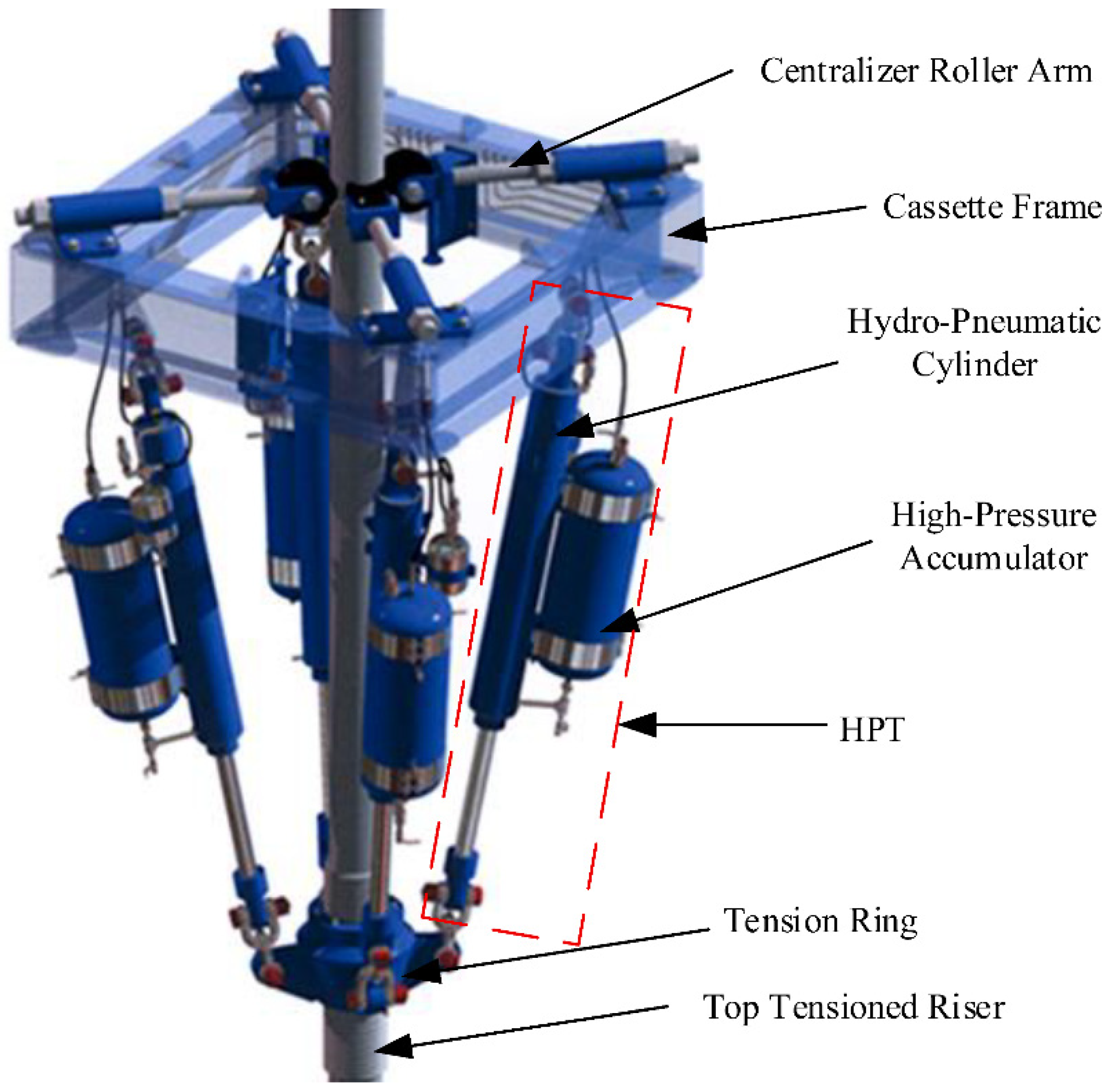
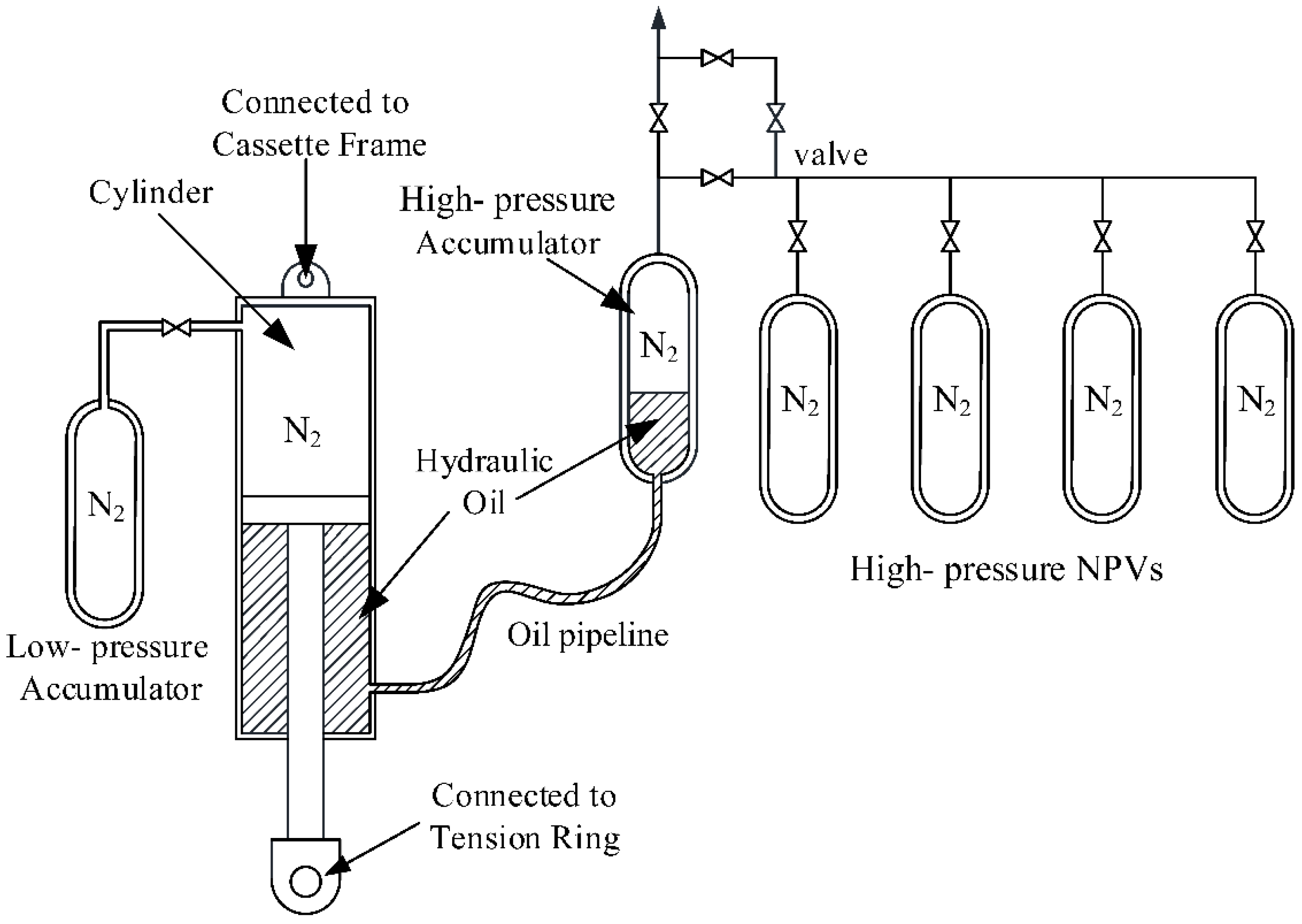
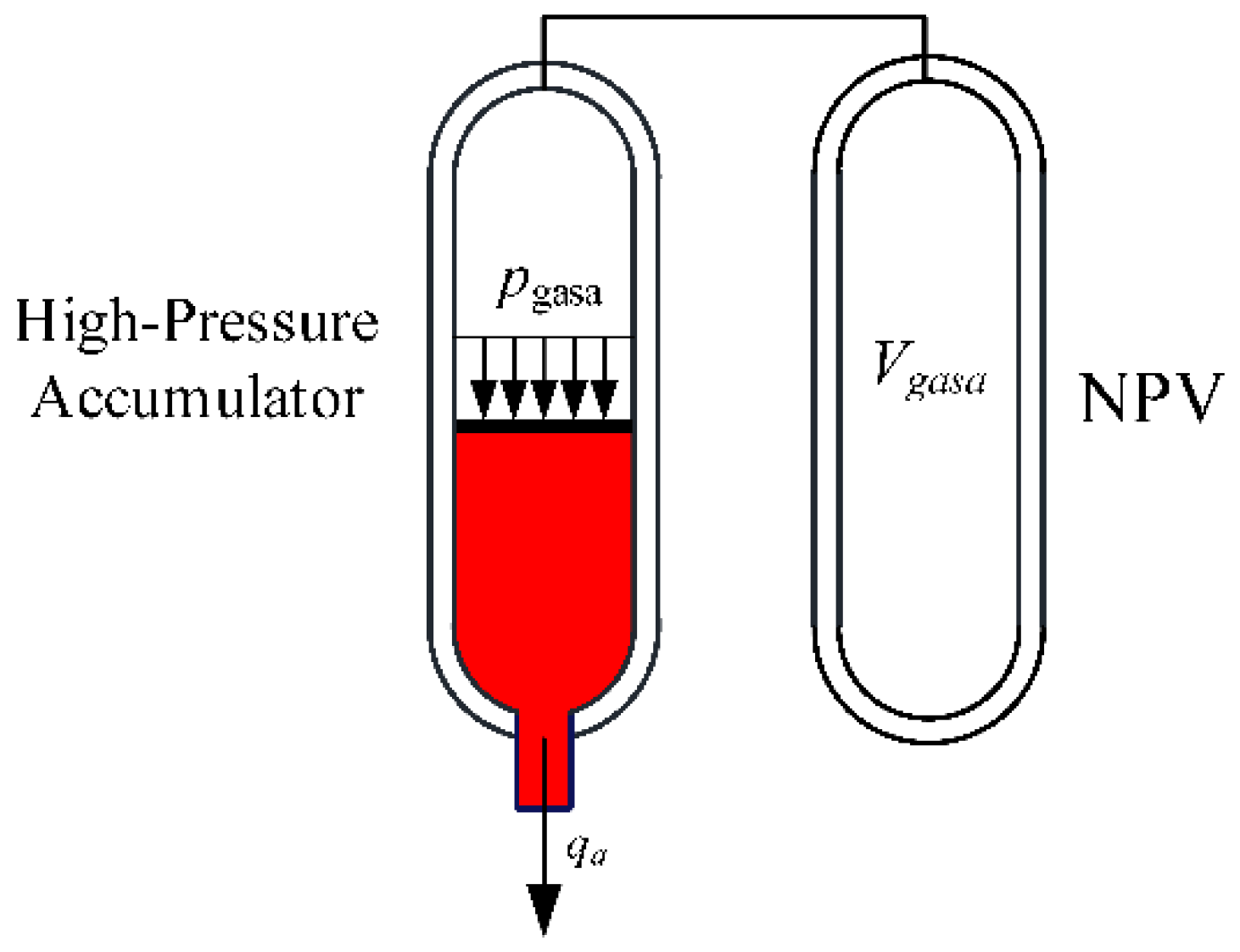


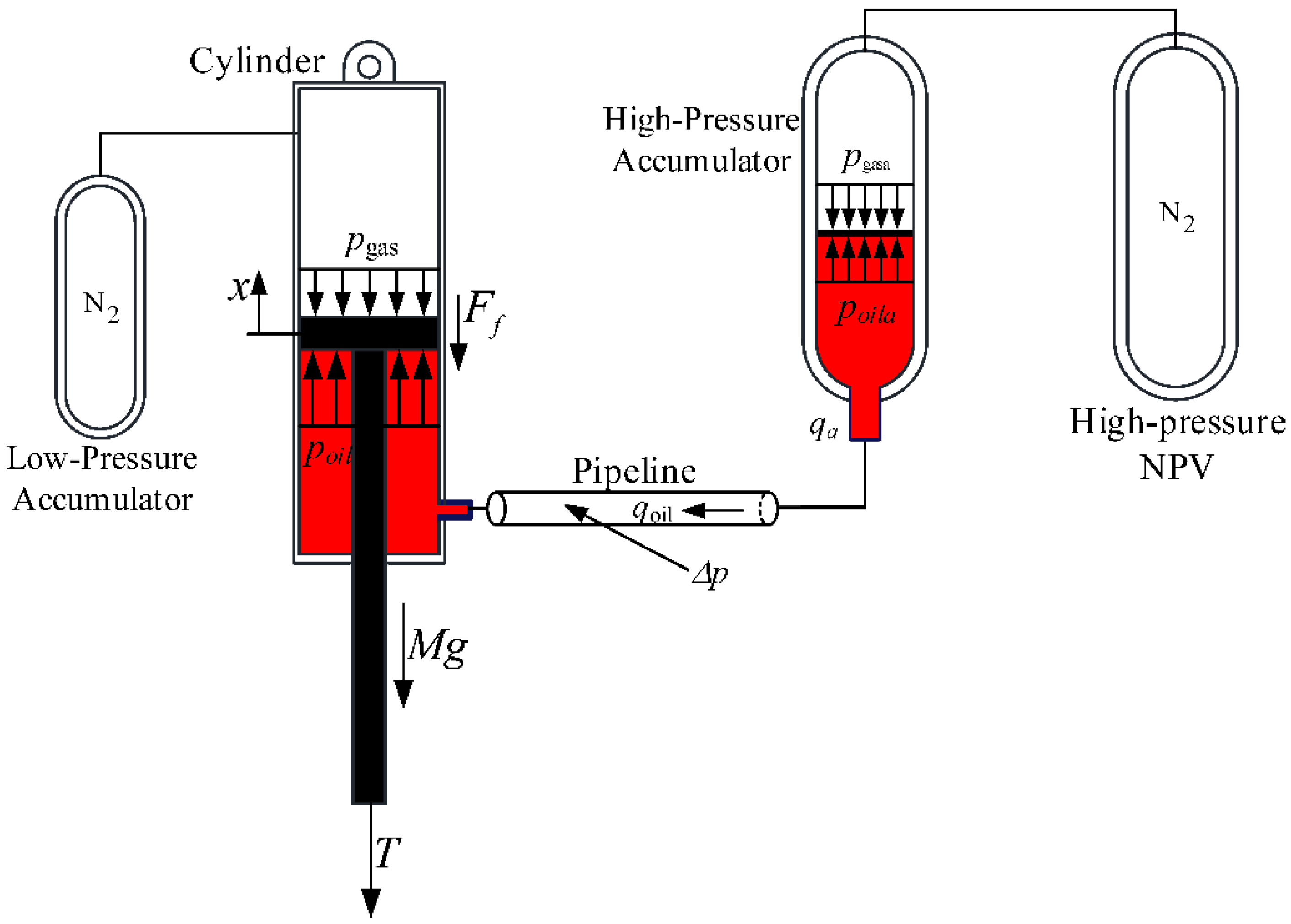
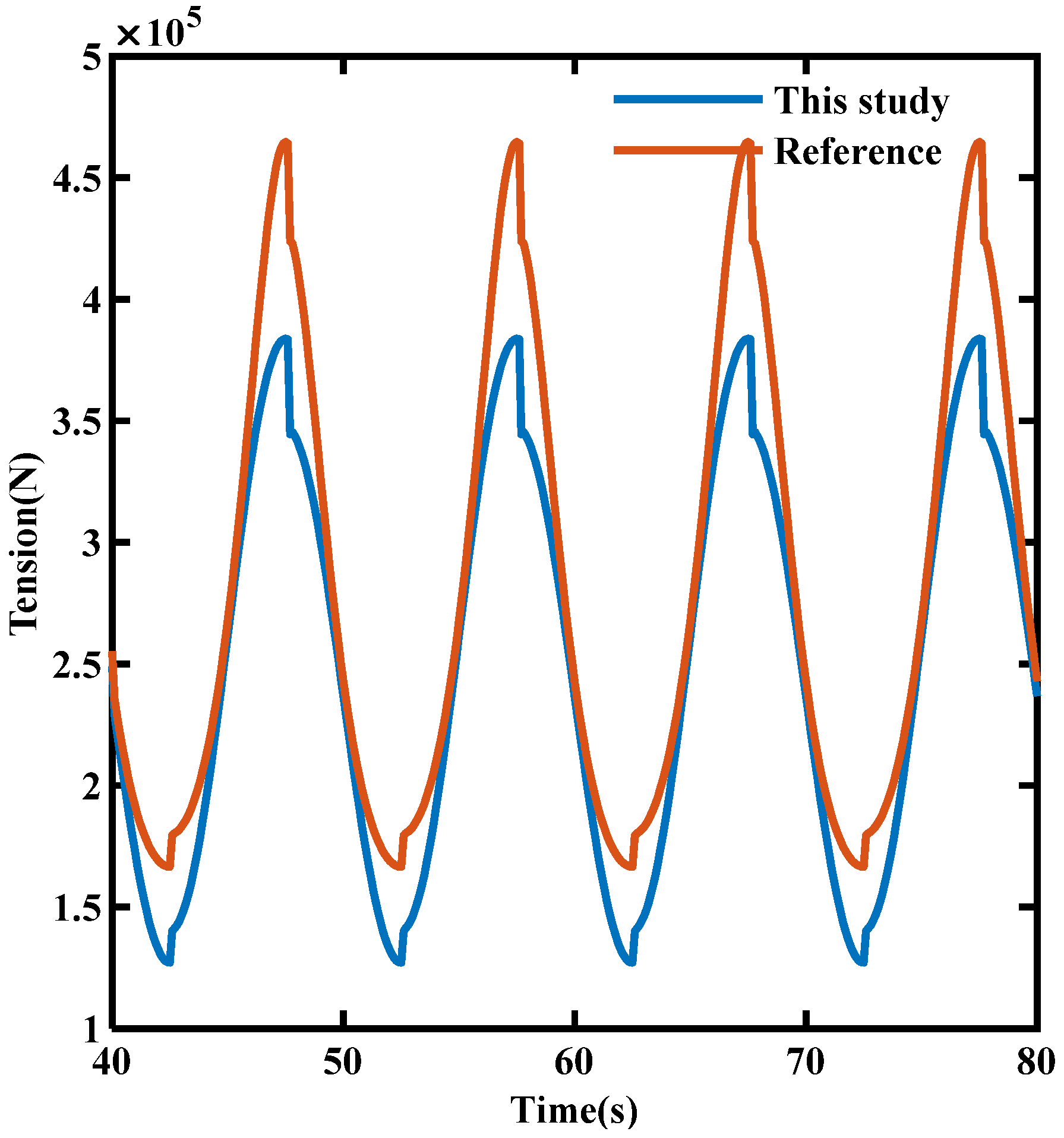
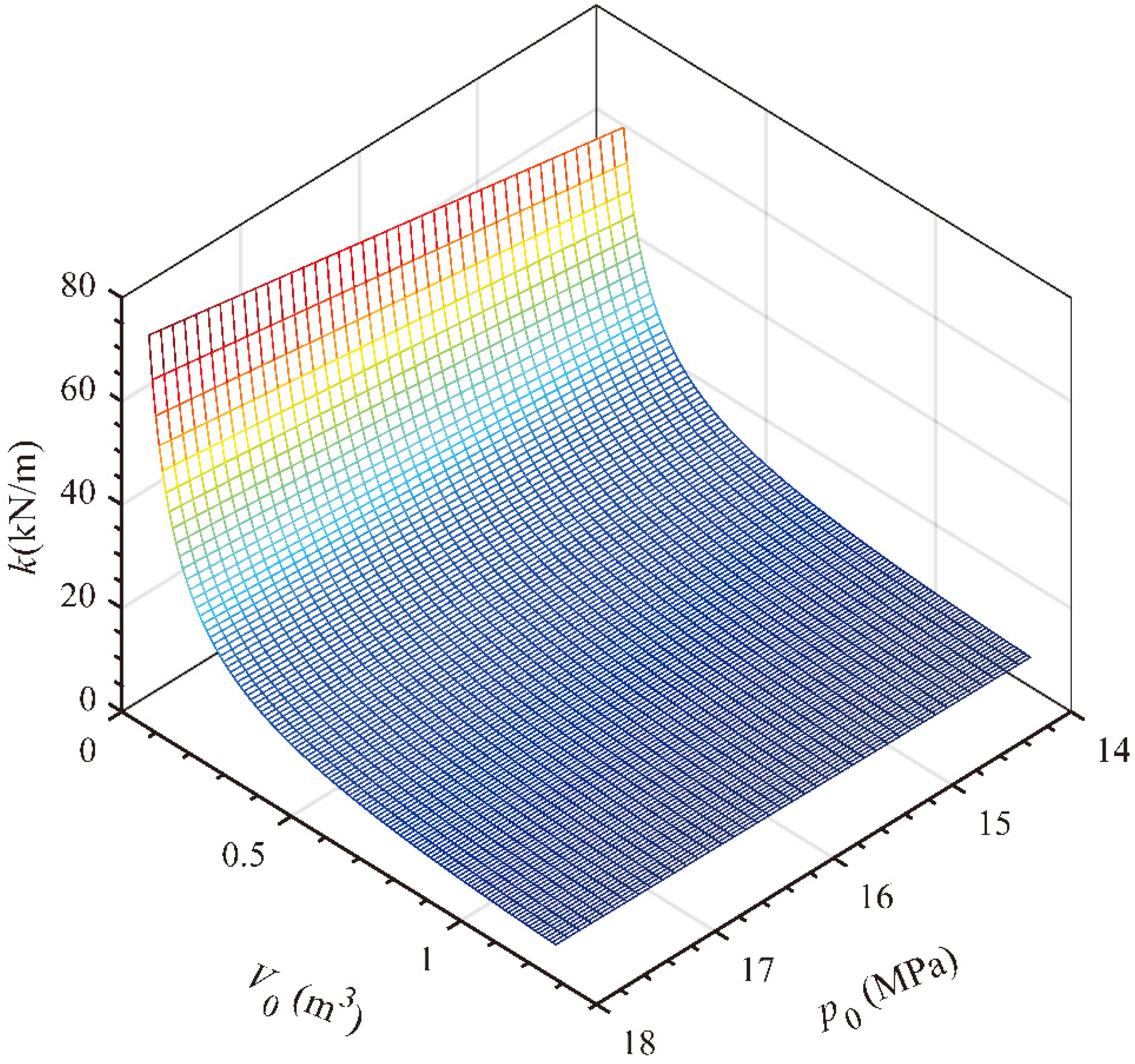
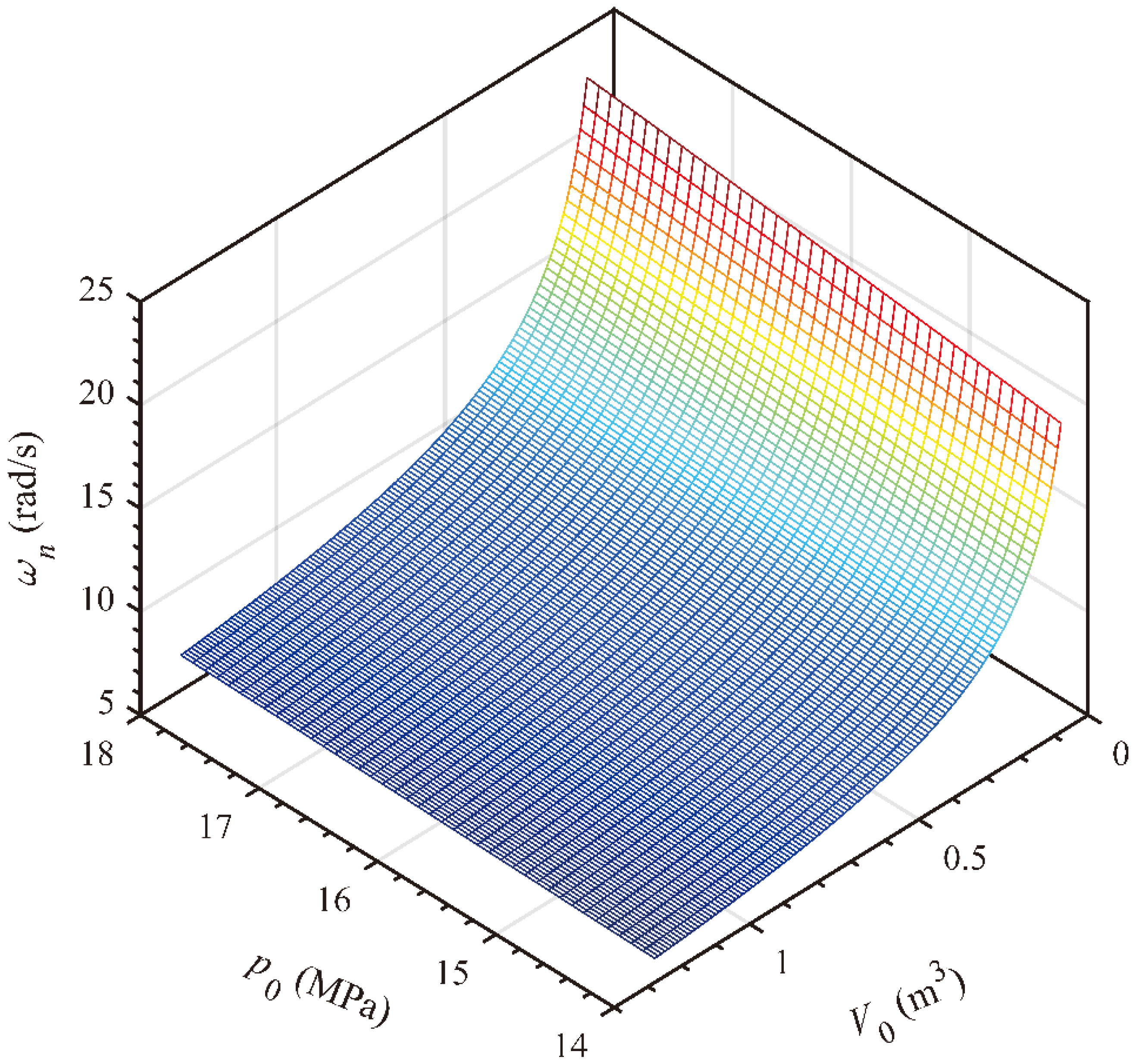
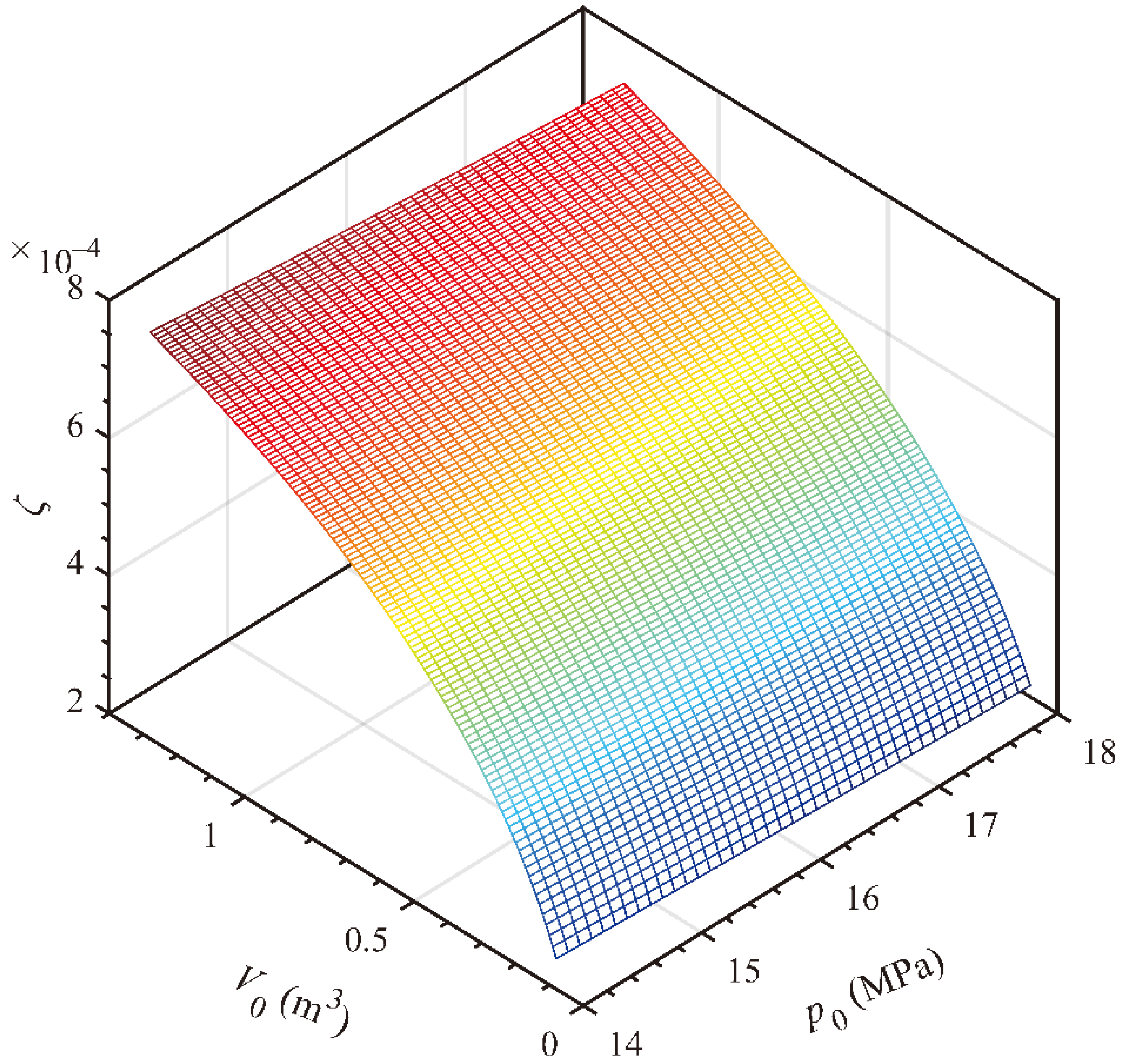

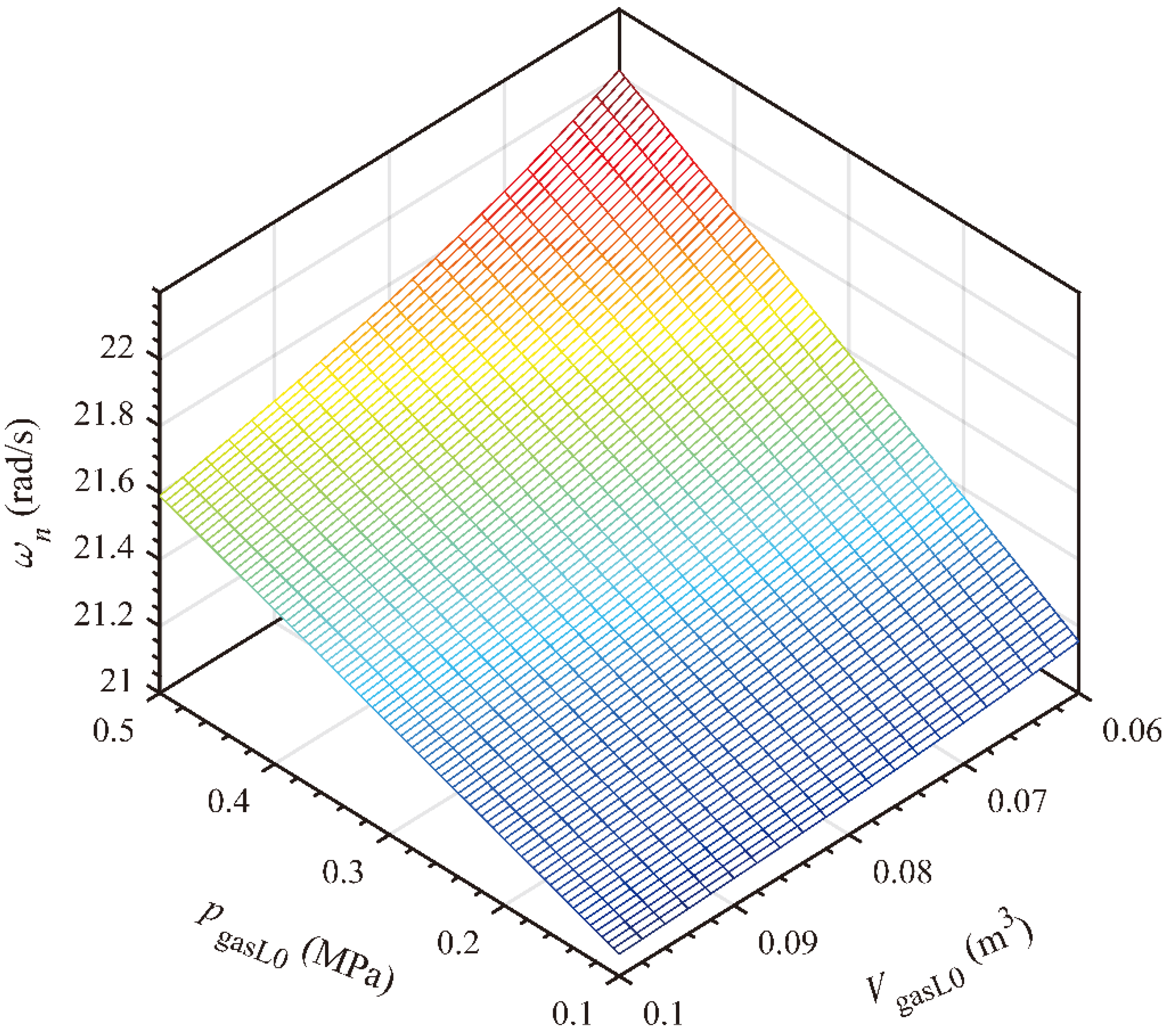
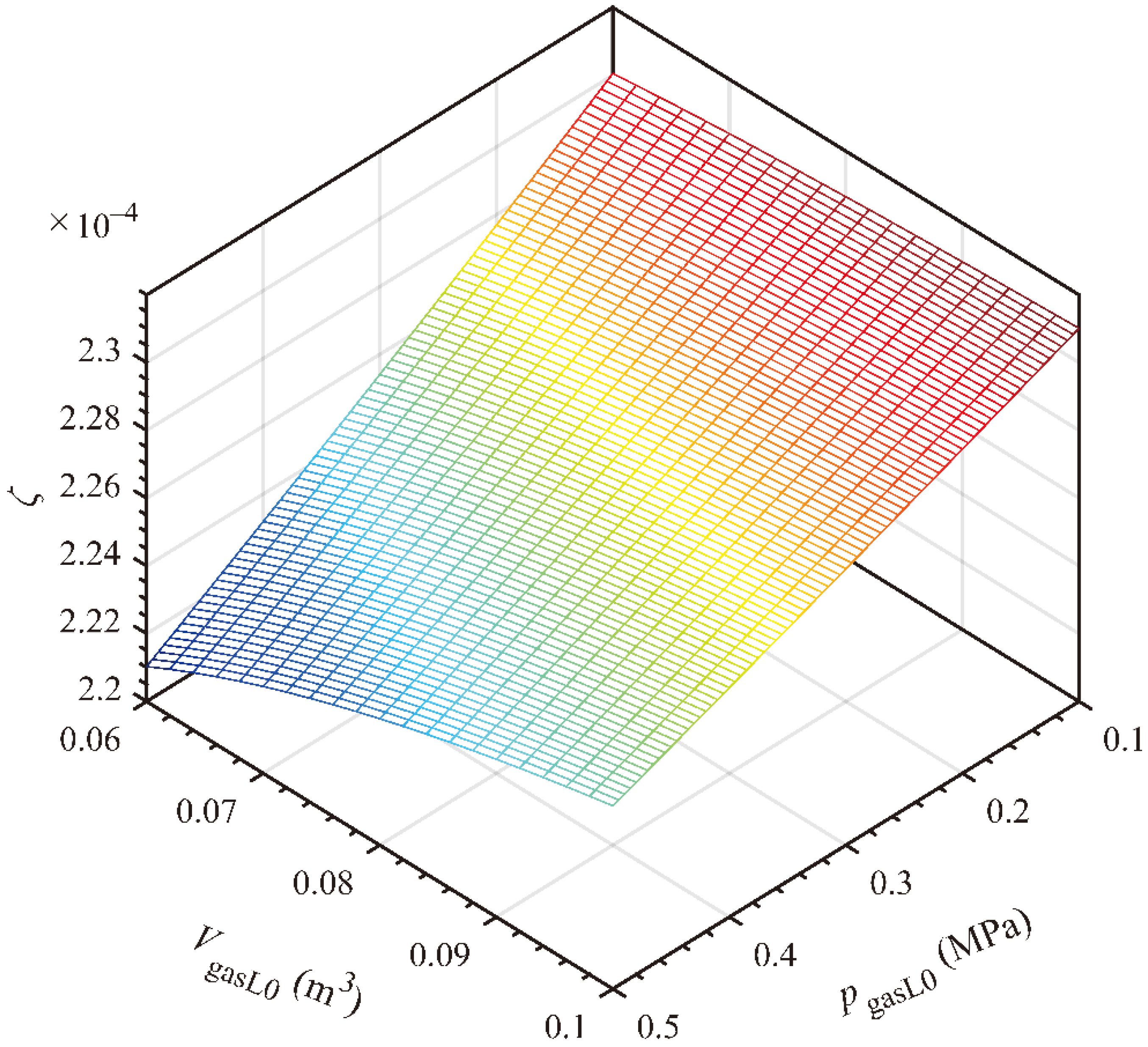
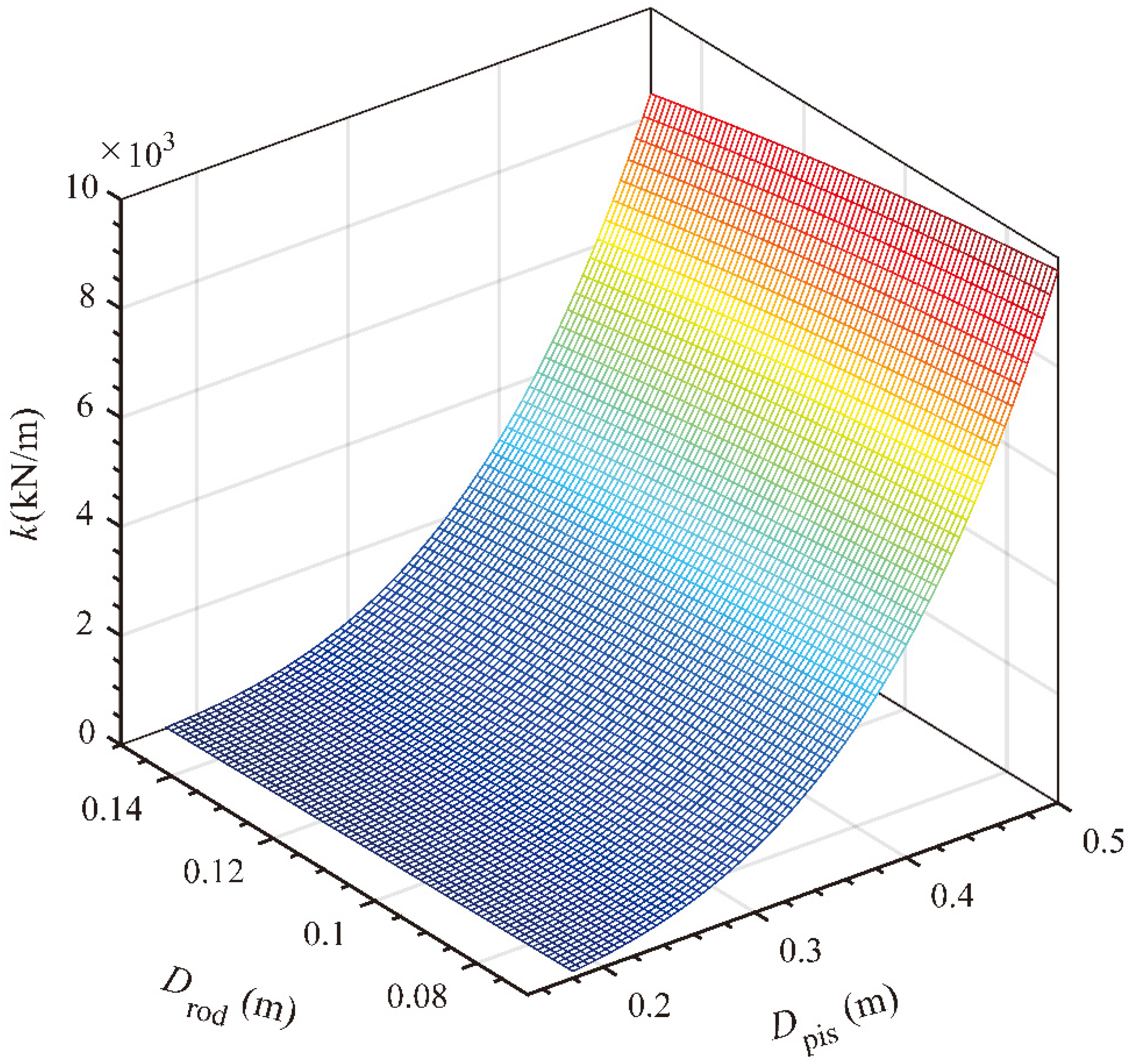
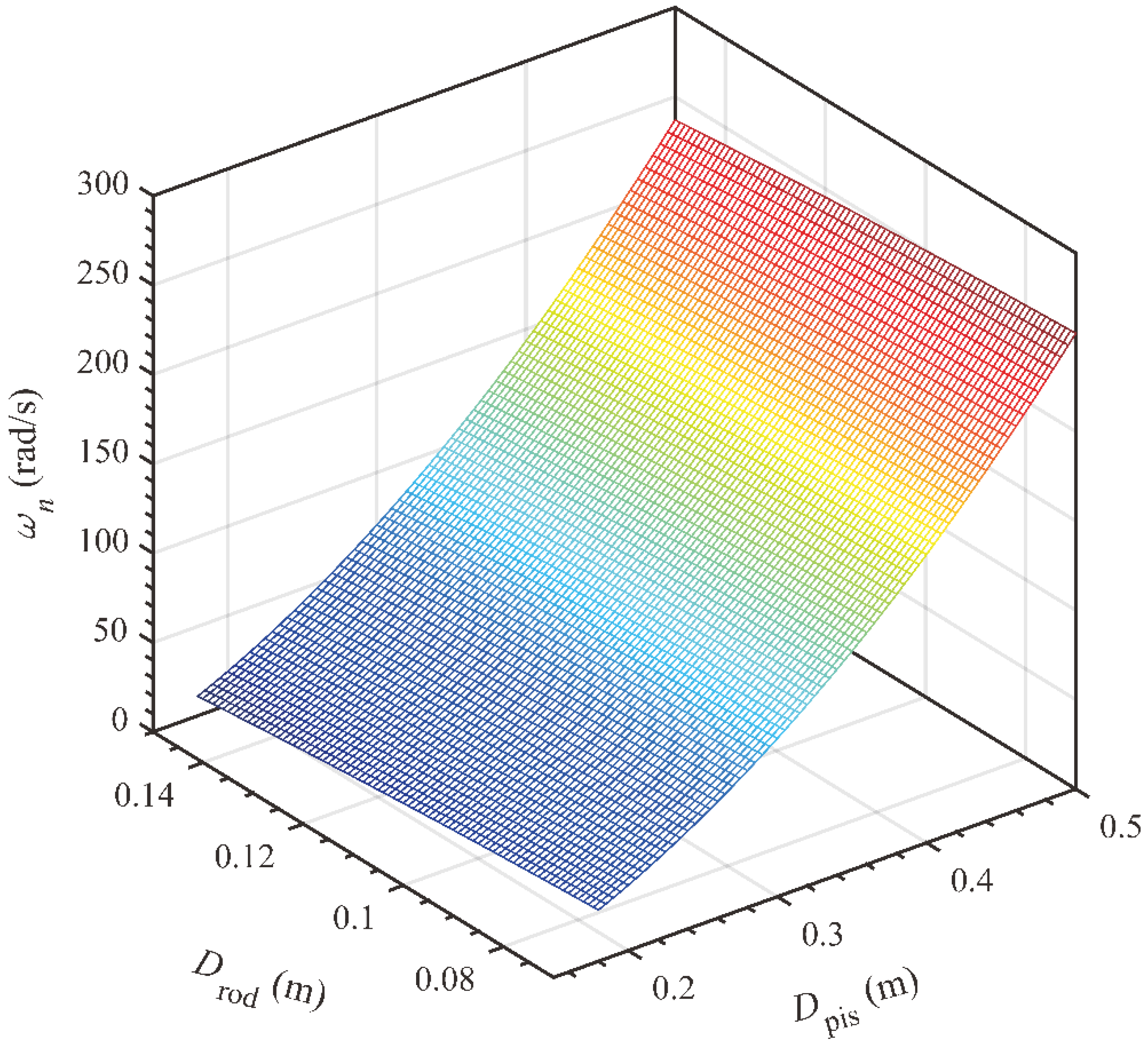

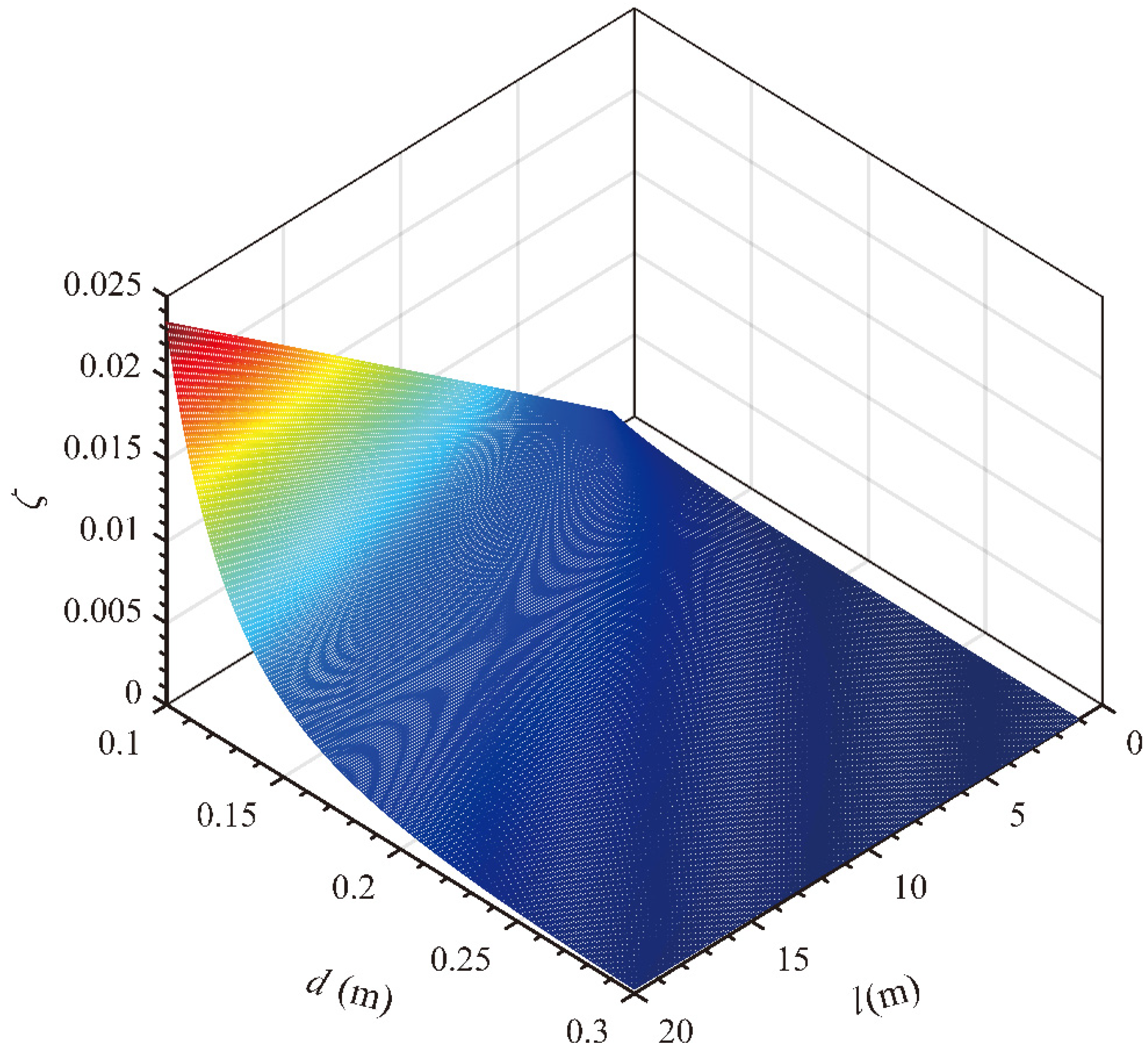
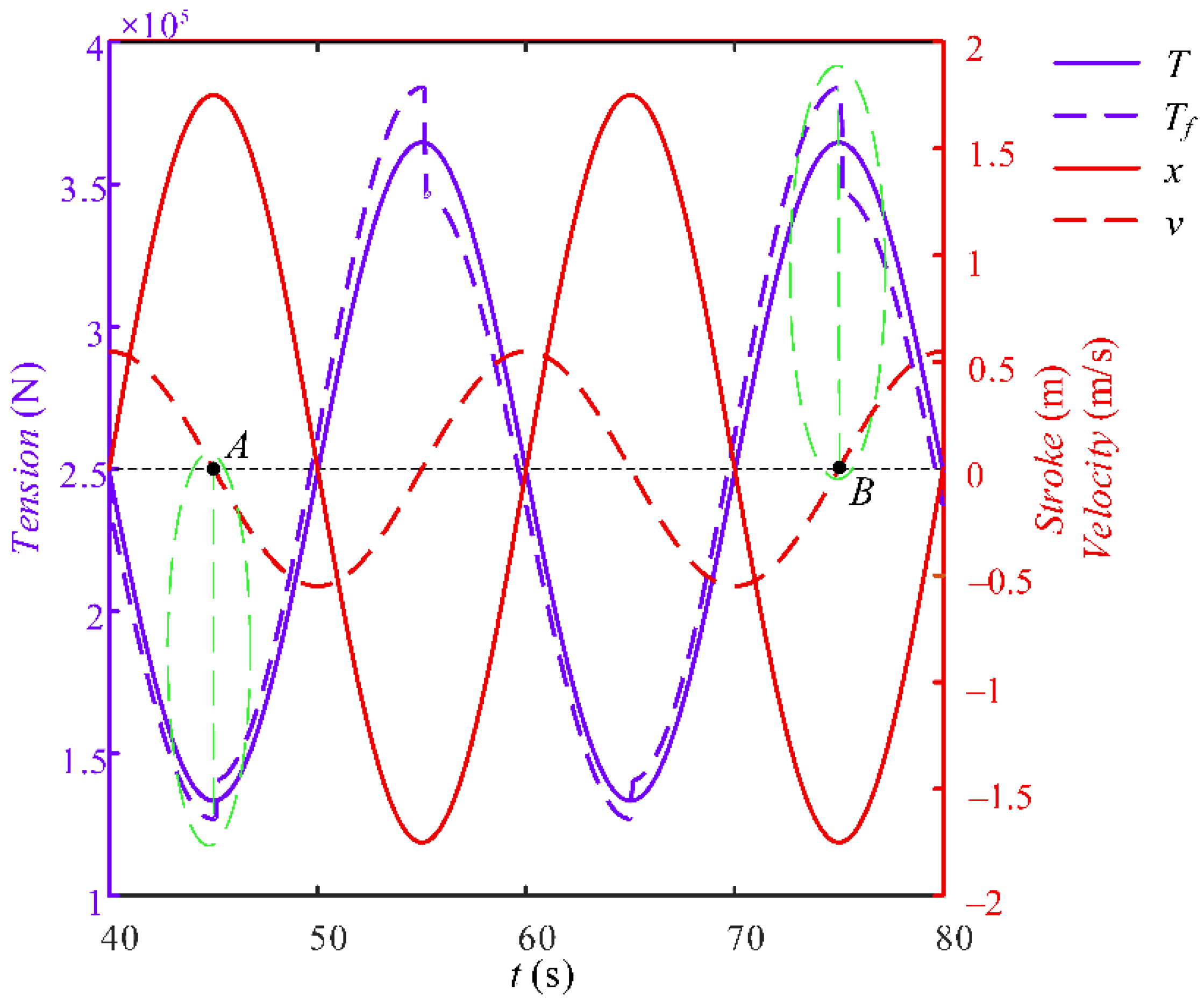
| Component | Parameter | Symbol | Unit | Value |
|---|---|---|---|---|
| Pipeline | length | l | m | 1.0 |
| inner diameter | d | m | 0.15 | |
| Hydraulic oil | kinematic viscosity | υ | 10−6 m2/s | 84.24 |
| dynamic viscosity | u | 10−2 kg/(m s) | 7.16 | |
| density | ρ | kg/m3 | 850 | |
| Hydraulic cylinder | piston diameter | Dpis | m | 0.18 |
| diameter of piston rod | Drod | m | 0.11 | |
| mass of piston and piston rod | M | kg | 150 | |
| High-pressure accumulator | initial pressure | p0 | MPa | 16 |
| initial volume | V0 | m3 | 0.080 | |
| Low-pressure accumulator | initial pressure | pgasL0 | MPa | 0.20 |
| initial volume | VgasL0 | m3 | 0.080 | |
| gas constant | n | 1.3 |
| Parameter | Symbol | Unit | Value |
|---|---|---|---|
| Throttling coefficient | Cc | m3/(Pa s) | 1.74 × 10−4 |
| Stiffness coefficient | k | kN/m | 66.1 |
| Damping coefficient | C | N/(m/s) | 1.46 |
| Initial tension | T0 | kN | 249 |
| Natural angular frequency | ωn | rad/s | 20.99 |
| Damping ratio | ζ | 2.32 × 10−4 |
Publisher’s Note: MDPI stays neutral with regard to jurisdictional claims in published maps and institutional affiliations. |
© 2021 by the authors. Licensee MDPI, Basel, Switzerland. This article is an open access article distributed under the terms and conditions of the Creative Commons Attribution (CC BY) license (https://creativecommons.org/licenses/by/4.0/).
Share and Cite
Wang, W.; Gong, H.; Wang, L.; Yun, F. Frequency Response Function and Design Parameter Effects of Hydro-Pneumatic Tensioner for Top-Tensioned Riser. Processes 2021, 9, 2239. https://doi.org/10.3390/pr9122239
Wang W, Gong H, Wang L, Yun F. Frequency Response Function and Design Parameter Effects of Hydro-Pneumatic Tensioner for Top-Tensioned Riser. Processes. 2021; 9(12):2239. https://doi.org/10.3390/pr9122239
Chicago/Turabian StyleWang, Wuchao, Haixia Gong, Liquan Wang, and Feihong Yun. 2021. "Frequency Response Function and Design Parameter Effects of Hydro-Pneumatic Tensioner for Top-Tensioned Riser" Processes 9, no. 12: 2239. https://doi.org/10.3390/pr9122239
APA StyleWang, W., Gong, H., Wang, L., & Yun, F. (2021). Frequency Response Function and Design Parameter Effects of Hydro-Pneumatic Tensioner for Top-Tensioned Riser. Processes, 9(12), 2239. https://doi.org/10.3390/pr9122239






